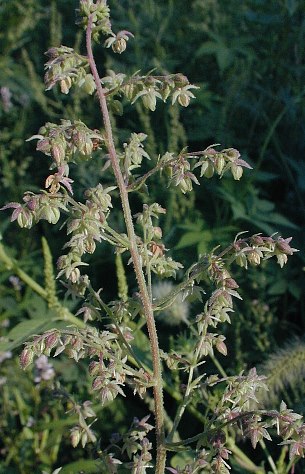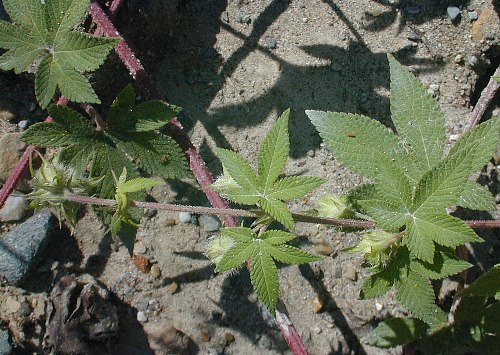Description:
This annual vine is 3-20' long, branching occasionally. The
twining habit of its stems allows this vine to climb adjacent
vegetation and fences; otherwise, it sprawls across the ground. The
rather stout stems are light green to reddish purple and longitudinally
ridged. Along the ridges of each stem, there are rows of stiff prickly
hairs. Pairs of opposite leaves occur at intervals along each stem.
These leaves are up to 6" long and 6" across and palmately divided into
5-7 lobes. Each lobe is oblanceolate or
elliptic in shape with coarsely
serrated margins. The upper surface of each leaf is medium green and
sparsely covered with short rough hairs, while the lower surface has
stiff prickly hairs along the major veins. The rather stout petioles
are as long
as, or a little shorter than, their leaves; these petioles are light
green and covered with stiff prickly hairs. Japanese Hops is dioecious,
with female (pistillate) and male (staminate) flowers produced on
separate vines. The female inflorescence is a short spike of flowers
and their bracts. This spike becomes globoid with age and tends to nod
downward, spanning about 1½" across. The appearance of each spike is
dominated by several overlapping pistillate bracts; at the base of each
bract, there is a pair of inconspicuous female flowers. Initially, the
pistillate bracts are narrowly deltoid in shape, but they later enlarge
in size and become deltoid with recurved tips. These bracts are light
green, hairy, and strongly ciliate along their smooth margins. Each
female flower has a divided style and an inconspicuous calyx that
surrounds the developing ovary; there are no petals. The male
inflorescence consists of a panicle of flowers up to 10" long and half
as much across; this inflorescence is more or less erect with ascending
to widely spreading lateral branches. The hairy branches of each
panicle are light green to pale red (usually the latter); there is a
pair of small linear bracts at the base of each branch. Individual male
flowers are about 1/8" (3 mm.) across, consisting of 5 spreading
sepals, 5
anthers, and no petals; they usually droop downward from the branches.
The sepals are elliptic in shape and vary in color from light green to
pale red (usually the latter). Both male and female inflorescences are
axillary (non-terminal). The blooming period occurs from mid-summer to
early fall and lasts about 2 months. The flowers are wind-pollinated.
Each female flower produces a single seed that is ovoid and flattened.
This vine reproduces by reseeding itself. It often forms dense colonies
of overlapping vines.
lobe is oblanceolate or
elliptic in shape with coarsely
serrated margins. The upper surface of each leaf is medium green and
sparsely covered with short rough hairs, while the lower surface has
stiff prickly hairs along the major veins. The rather stout petioles
are as long
as, or a little shorter than, their leaves; these petioles are light
green and covered with stiff prickly hairs. Japanese Hops is dioecious,
with female (pistillate) and male (staminate) flowers produced on
separate vines. The female inflorescence is a short spike of flowers
and their bracts. This spike becomes globoid with age and tends to nod
downward, spanning about 1½" across. The appearance of each spike is
dominated by several overlapping pistillate bracts; at the base of each
bract, there is a pair of inconspicuous female flowers. Initially, the
pistillate bracts are narrowly deltoid in shape, but they later enlarge
in size and become deltoid with recurved tips. These bracts are light
green, hairy, and strongly ciliate along their smooth margins. Each
female flower has a divided style and an inconspicuous calyx that
surrounds the developing ovary; there are no petals. The male
inflorescence consists of a panicle of flowers up to 10" long and half
as much across; this inflorescence is more or less erect with ascending
to widely spreading lateral branches. The hairy branches of each
panicle are light green to pale red (usually the latter); there is a
pair of small linear bracts at the base of each branch. Individual male
flowers are about 1/8" (3 mm.) across, consisting of 5 spreading
sepals, 5
anthers, and no petals; they usually droop downward from the branches.
The sepals are elliptic in shape and vary in color from light green to
pale red (usually the latter). Both male and female inflorescences are
axillary (non-terminal). The blooming period occurs from mid-summer to
early fall and lasts about 2 months. The flowers are wind-pollinated.
Each female flower produces a single seed that is ovoid and flattened.
This vine reproduces by reseeding itself. It often forms dense colonies
of overlapping vines.
Cultivation:
Japanese Hops prefers full to partial sun and moist to dry-mesic
conditions. It tolerates almost any kind of soil (sandy, gravelly,
loamy, or full of clay), but grows most vigorously in moist fertile
loam.
This vine can spread aggressively by reseeding itself. While this plant
is an annual in Illinois, it can survive the winter in warmer climates.
Range & Habitat:
Japanese Hops is occasional in some areas of Illinois (particularly the
central and northern regions of the state), but it is still absent from
other areas (see Distribution
Map). However, this species is still spreading into new areas
and it may eventually become a major weed. As the common name suggests,
this species is native to East Asia; it was probably introduced into
the United States as an ornamental plant. Habitats include disturbed
weedy meadows, banks of rivers and drainage ditches, banks along ponds,
open areas along railroads and roadsides, construction sites, and waste
ground. Recently disturbed habitats with exposed open ground are
especially preferred; this species also seems to prefer open slopes
along bodies of water where there is little or no mowing.

Faunal
Associations:
While photographing this vine, I observed several honeybees
collecting the abundant
pollen from the staminate flowers; other bees and flower flies are
attracted to the pollen as well, although none of these insects are
effective at cross-pollination (they don't visit the female flowers).
The caterpillars of several butterflies sometimes feed on hop vines
(Humulus spp.); they include Strymon melinus (Gray Hairstreak), Polygonia comma (Comma), Polygonia interrogationis (Question Mark), and Vanessa atalanta (Red Admiral). Other insect feeders include the caterpillars of several moths, Psylliodes humuli (Hop Flea Beetle), Phorodon humuli (Hop Aphid), and Neohydatothrips beachae (Hop
Thrips). The Insect Table has a more complete list of these insect
feeders. The coarse foliage of hops apparently is not preferred as a
source of food to mammalian herbivores.
Photographic Location:
Judge Webber Park in Urbana, Illinois, where some recent construction
activity occurred. This species also grows along the banks of ponds and
drainage ditches in the area.
Comments:
Even though they are superficially similar in appearance, it is
relatively easy to distinguish Japanese Hops from Humulus
lupulus (American Hops). Japanese Hops has leaves with mostly
5-7 lobes, while American Hops has leaves with 3 lobes or none. Because
of the color of its sepals and branches, the staminate inflorescence of
Japanese Hops is often pale red in appearance, while the staminate
inflorescence of American Hops is usually pale yellow. The pistillate
spikes of Japanese Hops are globoid in shape and they have recurved
deltoid bracts (triangular-shaped with slender tips that bend backward)
that are hairy. In contrast, the pistillate spikes of American Hops are
ovoid in shape and they have hairless ovate bracts with blunt tips that
are straight or bend slightly inward.